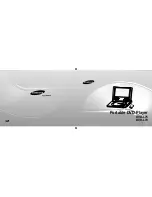
32
Glossary
Analog:
Sound that has not been turned into
numbers. Analog sound varies, while digital sound
has speci
fi
c numerical values. These jacks send
audio through two channels, the left and right.
Aspect ratio:
The ratio of vertical and horizontal
sizes of a displayed image. The horizontal vs. vertical
ratio of conventional TVs is 4:3, and that of wide
screens is 16:9.
AUDIO OUT jacks:
Jacks on the back of the DVD
System that send audio to another system (TV,
Stereo, etc.).
Bit Rate:
The amount of data used to hold a given
length of music; measured in kilobits per seconds, or
kbps. Or, the speed at which you record. Generally,
the higher the bit rate, or the higher the recording
speed, the better the sound quality. However, higher
bit rates use more space on a disc.
Chapter:
Sections of a picture or a music piece on a
DVD that are smaller than titles. A title is composed
of several chapters. Each chapter is assigned a
chapter number enabling you to locate the chapter
you want.
Component Video Out jacks:
Jacks on the back of
the DVD System that send high-quality video to a TV
that has Component Video In jacks.
Disc menu:
A screen display prepared for allowing of
selection of images, sound, subtitle, multi-angles etc.
recorded on the DVD.
Digital:
Sound that has been converted into
numerical values. Digital sound is available when you
use the DIGITAL AUDIO OUT COAXIAL jack. These
jacks send audio through multiple channels, instead
of just two channels as analog does.
Dolby Digital:
A surround sound system developed
by Dolby Laboratories containing up to six channels
of digital audio (front left and right, surround left and
right, center and subwoofer).
HDMI (High-De
fi
nition Multimedia Interface):
HDMI is a digital interface for consumer electronic
products. Unlike conventional connections, it
transmits uncompressed digital video and audio
signals on a single cable.
JPEG:
A very common digital still picture format. A
still-picture data compression system proposed by
the Joint Photographic Expert Group, which features
small decrease in image quality in spite of its high
compression ratio.
Multichannel:
DVD is speci
fi
ed to have each
soundtrack constitute one sound
fi
eld. Multichannel
refers to a structure of soundtracks having three or
more channels.
Parental Control:
A function of the DVD to limit
playback of the disc by the age of the users
according to the limitation level in each country. The
limitation varies from disc to disc; when it is activated,
playback will be prohibited if the software’s level is
higher than the user-set level.
PCM (Pulse Code Modulation):
A system for
converting analog sound signal to digital for later
processing, with no data compression used in
conversion.
Playback control (PBC):
Refers to the signal
recorded on Video CDs or SVCDs for controlling
reproduction. By using menu screens recorded on a
Video CD or SVCD that supports PBC, you can enjoy
interactive-type software as well as software having a
search function.
Progressive Scan:
It displays all the horizontal
lines of a picture at one time, as a signal frame.
This system can convert the interlaced video from
DVD into progressive format for connection to a
progressive display. It dramatically increases the
vertical resolution.
Region Code:
A system for allowing discs to
be played back only in the region designated
beforehand.
This unit will only play discs that have compatible
region codes. You can
fi
nd the region code of your
unit by looking on the product label. Some discs are
compatible with more than one region (or All regions).
Title:
The longest section of a picture or music
feature on DVD, music, etc., in video software, or the
entire album in audio software. Each title is assigned
a title number enabling you to locate the title you
want.
VIDEO OUT jack:
Jack on the back of the DVD
System that sends video to a TV.
32
DVD-S58̲S38̲PP-En.indd 32
DVD-S58̲S38̲PP-En.indd 32
2010/01/08 16:27:21
2010/01/08 16:27:21
Summary of Contents for DVDS38 - DVD/CD PLAYER - MULTI LANGUAGE
Page 35: ...35 ENGLISH 35 ...
















































